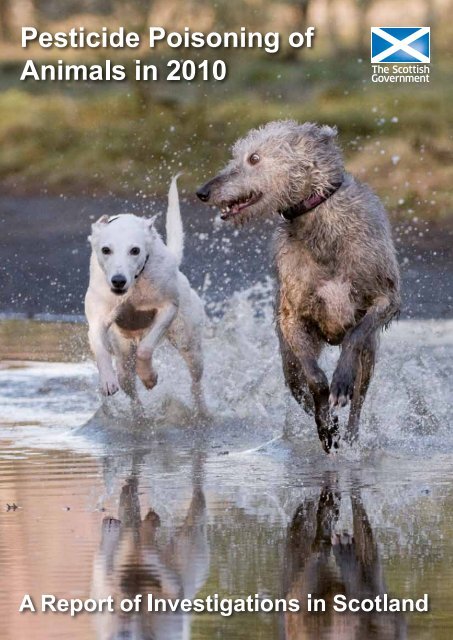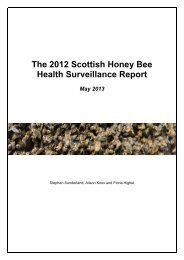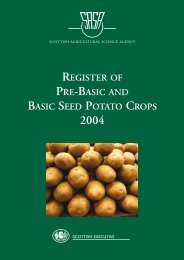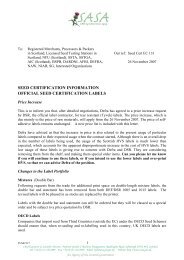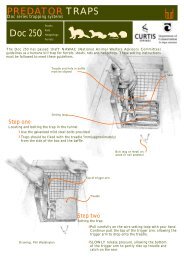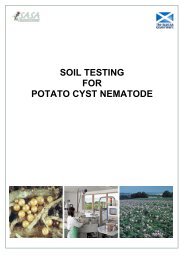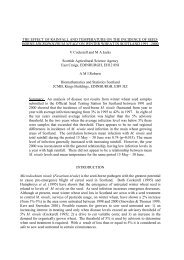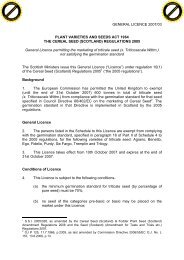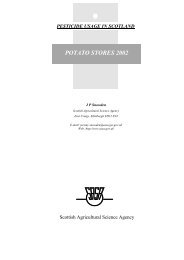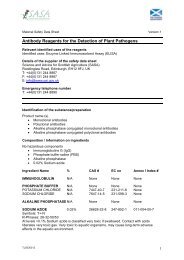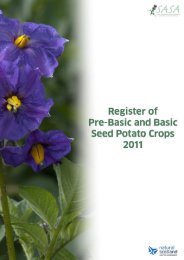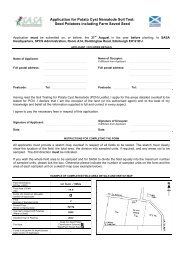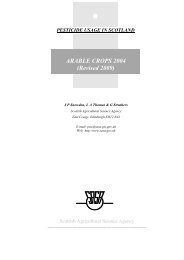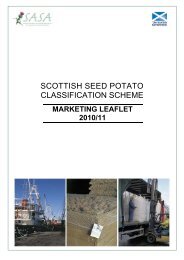Pesticide Poisoning Report 2010 - SASA
Pesticide Poisoning Report 2010 - SASA
Pesticide Poisoning Report 2010 - SASA
Create successful ePaper yourself
Turn your PDF publications into a flip-book with our unique Google optimized e-Paper software.
PESTICIDE POISONING OF ANIMALS IN <strong>2010</strong>INVESTIGATIONS OF SUSPECTED INCIDENTS IN SCOTLANDM J Taylor, E A Sharp, J E Watson and L M Melton<strong>SASA</strong>, <strong>Pesticide</strong>s & WildlifeRoddinglaw Road, Edinburgh EH12 9FJScience and Advice for Scottish AgricultureA Division of the Scottish GovernmentRural Payments and Inspections Directorate
SummaryThe Wildlife Incident Investigation Scheme (WIIS) operated in Scotland by Scienceand Advice for Scottish Agriculture (<strong>SASA</strong>) <strong>Pesticide</strong>s & Wildlife Branch investigatessuspected poisoning of wildlife, beneficial insects, companion animals and livestockif there is evidence to indicate that pesticides or biocides 1 may be involved.The scheme, together with similar schemes operating in England & Wales andNorthern Ireland, provides a means of post-registration surveillance of pesticide usethroughout the UK, so that registration may be revised if necessary. These schemesalso provide a measure of the success of the pesticide registration process and helpin the verification and improvement of the risk assessments made in the registrationof compounds. Incidents of approved use and of misuse can highlight problems withthe approval conditions or the label instructions for a pesticide, and can providevaluable feedback into the regulatory process.The scheme in Scotland also provides evidence that can be used by the ScottishGovernment or the police, to enforce legislation relating to the safe use of pesticidesand the protection of food, the environment and animals.In <strong>2010</strong>, 233 incidents (which included 5 bee incidents) were referred to the WIISScotland and represented a 40% increase in the number of submissions comparedto 2009. Five incidents were excluded 2 , leaving 228 incidents accepted for furtherinvestigation. The cause of death or illness was determined in 123 incidents andunknown in 105 incidents. 106 incidents (46% of all incidents accepted into the WIISScotland) tested positive for pesticide residues 3 .Thirty two incidents were categorised as abuse, 11 incidents were attributed tounspecified use, 2 incidents followed approved use, 2 incidents were a result ofmisuse and 3 incidents were attributed to veterinary use.Twenty five different pesticides 3 were identified. The insecticide, carbofuran wasdetected in 19 out of 32 (59%) incidents categorised as abuse, even though UKapproval for use of products containing this chemical expired in 2001.Selected samples were also screened for evidence of exposure to anticoagulantrodenticides. Residues of various anticoagulant rodenticides were detected in 72 outof 183 incidents (i.e. 39% of those incidents selected for rodenticide screening). Thesecond generation anticoagulant rodenticides, bromadiolone, brodifacoum anddifenacoum were found to be the most prevalent active ingredients detected. 11 In recent years, some non-agricultural or plant-protection pesticides have been classified asbiocides e.g. anticoagulant rodenticides. However, throughout this <strong>Report</strong> ‘pesticide’ or‘pesticides’ will be used as the generic terminology.2Excluded refers to incidents where the criteria for acceptance into the WIIS Scotland have notbeen met or where there is no suitable material for analysis.3Includes incidents that involved ethylene glycol and individual anticoagulant rodenticides.1
Introduction1. In the United Kingdom the impact of pesticide use on non-target vertebratewildlife and other animals including honey bees, companion animals andlivestock, is assessed before approval is granted by the regulatory body. Inorder to protect animals, restrictions on use may be imposed in the conditionsof approval made under the Control of <strong>Pesticide</strong>s Regulations (COPR) 1986(as amended) or the Plant Protection Products Regulations (1995), where it isthought that an unacceptable risk would arise.2. The WIIS Scotland is one of four schemes, operating in the United Kingdom,which investigates possible pesticide poisoning of animals. The WIISScotland is operated by <strong>SASA</strong>’s <strong>Pesticide</strong>s & Wildlife Branch on behalf of theScottish Government’s Rural Payments and Inspections Directorate(SGRPID). The procedures for incident investigation are described inAppendix I.3. Incidents confirmed as involving pesticides that were considered to beresponsible for the cause of death or illness of an animal or that contravenerelated legislation are assigned to one of the following categories:• Approved use of the product, according to the specified conditionsof use;• Misuse of a product, by careless, accidental or wilful failure toadhere to the correct practice;• Abuse of a pesticide, in the form of deliberate, illegal attempts topoison animals;• Unspecified use, where the cause could not be assigned to one ofthe above categories.• Veterinary use, where subsequent investigation identifies theinvolvement of a pesticide formulated as a veterinary medicine.Such cases are investigated incidentally rather than deliberately,and may include abuse, misuse, approved use, or unspecified useof the relevant compounds.4. The results of investigations are ultimately reported to the EnvironmentalPanel of the UK Advisory Committee on <strong>Pesticide</strong>s (ACP). The informationprovided may result in a re-evaluation of the approvals previously granted toproducts, or may affect the progress to full commercial use of productscurrently under provisional approval. Information from incidents assists in thevalidation and improvement of the risk assessment procedures used by theregulatory body for new and existing compounds.2
Table 2:<strong>Pesticide</strong>Identity and frequency of pesticides detected and sample types.Number ofpositive incidentsSample type aaldicarb 6 bait, golden eagle, peregrine falcon, red kitealdicarb sulfoxide 2 bait, peregrine falconaluminium phosphide 2 chemical, soilbrodifacoum 17 barn owl, buzzard, fox, grey heron, pig, rabbit,red kite, sparrowhawk, tawny owl, wood pigeonbromadiolone 56 barn owl, buzzard, crow, dog, fox, kestrel,peregrine falcon, pig, red kite, rabbit,sparrowhawk, tawny owl, wood pigeon, wildcatcarbofuran 20 bait, buzzard, chemical, crow, golden eagle, redkite, paraphernalia, sea eagle, sparrowhawk,wildcatcarbosulfan 4 buzzard, chemical, crow, red kitechloralose 3 bait, buzzard, red kitecyproconazole 1 soilDDE b 3 buzzard, sparrowhawkdiazinon 2 dog, ravendieldrin 1 buzzarddifenacoum 42 bait, barn owl, buzzard, dog, fox, grey heron,kestrel, pig, rabbit, red kite, sparrowhawk,waxwingdimetridazole 1 chemicaldiuron 1 soilethylene glycol 4 catfenbendazole 1 baitflocoumafen 2 buzzard, pigfluvalinate 1 honey beeisofenphos 3 buzzard, cat, paraphernaliamevinphos 1 baitparaquat 1 catpropiconazole 2 honey bee, soilsodium cyanide 3 chemicalthiacloprid 1 soilaIndividual incidents may have involved submissions of multiple and several sample typesand detection of >1 pesticide. b DDE (dichlorodiphenyldichloroethylene) is a break-downproduct of DDT.6
Species or sample typeNumber tested(+ive)Blackbird 2 (0)Greenfinch 1 (0)Pigeon – feral 4 (0)Waxwing 1 (1)Wood pigeon 5 (1)Cormorant 1 (0)Heron-grey 2 (1)Gannet 1 (0)Puffin 1 (0)Swan – mute or whooper 8 (0)Crow 7 (2)Magpie 2 (0)Raven 4 (1)Rook 2 (0)Companion AnimalsCat 15 (5)Dog 17 (7)Dove 3 (0)Horse 1 (0)LivestockCattle 2 (0)Chicken 2 (0)Pig 2 (1)Beneficial InsectsFeral bees 1 (0)Honey bees 4 (2)8
14. Ten different pesticides and/or their metabolites were detected and identifiedin abuse incidents in <strong>2010</strong>. The pesticides were aldicarb, aldicarb sulfoxide,aluminium phosphide, carbofuran, carbosulfan, chloralose, difenacoum,isofenphos, mevinphos and sodium cyanide.UNSPECIFIED USE15. Sometimes it is not possible to definitely establish the source of a pesticidewhich has been positively detected and is present at levels considered topose a significant risk of mortality. Such cases are categorised as‘Unspecified Use’ and in <strong>2010</strong>, eleven incidents fell into this category.Animals and pesticides involved in these incidents are listed in Table 5.Table 5: Unspecified Use incidents recorded in <strong>2010</strong>.Region <strong>Pesticide</strong>s Month SpeciesBorder brodifacoum, difenacoum April SparrowhawkBorderbrodifacoum, bromadiolone,difenacoumAugustRabbitLothian paraquat October CatCentralbrodifacoum, bromadiolone,difenacoumFebruary Fox (2)Dumfries &Gallowaybrodifacoum, bromadiolone,difenacoumMaySparrowhawk (2), Barnowl, Tawny owlGrampian bromadiolone, difenacoum March DogGrampian bromadiolone, difenacoum March Red kiteHighlandHighlandbrodifacoum, bromadiolone,difenacoumbrodifacoum, bromadiolone,difenacoumJuly Red kite (6)July Red kite (2)Tayside bromadiolone, difenacoum February BuzzardTayside bromadiolone February Dog12
VETERINARY USE16. Three incidents were classified as veterinary use and involved a raven andtwo dogs in separate incidents. Two ravens found dead by an estategamekeeper in Strathclyde were submitted for analysis. A residue ofdiazinon, an active ingredient used in sheep-dip formulations, a small orangecoloured rubber band and the remnants of a tail, presumed to be from a lamb,were found in the stomach content material from one of the birds. The fieldinvestigation established that the estate had been dipping sheep with‘Paracide Plus’ although not in the locality where the bird was found. Thesource of the chemical has not been established as the ravens could havescavenged over an extensive area where there are several other sheepenterprises.In an incident in the Borders a dog owner found that a piece of bread, coveredwith chocolate spread and some white powder, had been posted through theletterbox. There was concern that there was an intention to harm the dog.However, the analytical investigation established that the white powdercontained fenbendazole, the active ingredient in veterinary medicines used tocontrol gastrointestinal parasites.Another incident involving a dog was reported in Dumfries and Galloway. Ashepherd’s dog became ill after eating something it found whilst working.Vomiting was induced by a veterinary surgeon and the dog survived. Theanalytical investigation confirmed a residue of diazinon in the sample of vomitanalysed. The farm uses dip containing diazinon to control ectoparasites onsheep and cattle. However, the exact source of the chemical still remainsuncertain.Anticoagulant Rodenticides17. Non-target animals are occasionally casualties of poisoning caused by wilfulor accidental non-compliance with good practice in rodenticide baiting.Indirect or secondary poisoning can also occur when predators, scavengersor curious animals ingest rodents killed or affected by rodenticides. The WIISScotland offers a unique opportunity to probe wider environmentalcontamination by looking for rodenticide residues present in non-targetanimals that otherwise would not be available. Routine monitoring of livertissue from wild mammals, birds of prey and other animals is carried out inorder to assess the magnitude and frequency of exposure to anticoagulantrodenticides. The results provide an effective indication of the non-targetanimals exposed to anticoagulant rodenticides.In <strong>2010</strong>, <strong>SASA</strong> <strong>Pesticide</strong>s & Wildlife Branch tested 214 livers from a variety ofanimals for the presence of residues of anticoagulant rodenticides. Residueswere detected and identified in the livers of 82 specimens i.e. 38% of the totalnumber of livers tested (Table 6).13
Table 6:Species tested throughout <strong>2010</strong> for the presence of residues ofanticoagulant rodenticides a .SpeciesNumbertestedNumber positive bBuzzard 65 32Eagle-golden 5 -Eagle-sea 1 -Hen harrier 2 -Kestrel 2 1Peregrinefalcon6 2Red kite 22 17Sparrowhawk 16 10Barn Owl 11 5Short-earedOwl1 -Tawny owl 3 2Crow 6 1Magpie 2 -Raven 4 -Rook 2 -Blackbird 2 -Dove 3 -Greenfinch 1 -Pigeon (all) 9 1Waxwing 1 114
SpeciesNumbertestedNumber positive bCormorant 1 -Gannet 1 -Grey heron 2 1Puffin 1 -Swan 8 -Badger 1 -Cat 7 -Dog 11 4Fox 5 2Horse 1 -Meercat 1 -Otter 1 -Rabbit 1 1Rat 1 -Squirrel-Red 2 -Wildcat 1 1Cattle 2 -Chicken 2 -Pig 1 1TOTAL 214 82aRodenticides (i.e. active ingredients) sought routinely include brodifacoum, bromadiolone,chlorophacinone, coumatetralyl, difenacoum, diphacinone, flocoumafen & warfarin.bThis is the total number of specimens that tested positive from 214 livers examined. Anindividual WIIS incident may involve >1 specimen.15
APPENDIX IINVESTIGATION PROCEDURESThe investigation of suspected pesticide poisoning incidents relies on a scheme,which allows members of the public and interested organisations to submit carcases,suspected baits or other samples for pesticide analysis. The Wildlife IncidentInvestigation Scheme is operated in Scotland by the <strong>Pesticide</strong>s and Wildlife Branchat <strong>SASA</strong> on behalf of the Scottish Government. Agricultural Staff in area officeslocated throughout Scotland, provide support when necessary for field investigations,and also act as an additional point of contact for notification of incidents.A number of environmental and animal welfare organisations, such as the RSPB-Scotland and the Scottish Society for the Prevention of Cruelty to Animals, play anactive role in some incident investigations. These bodies act not only by assistingmembers of the public to notify incidents, but also by screening out inappropriatecases prior to notification.The Scottish Agricultural College (SAC) Veterinary Service acts in partnership withthe scheme, in forwarding relevant samples to <strong>SASA</strong> from potential incidents notifiedindirectly via its laboratories, and by screening out incidents that are unlikely toinvolve pesticides. The Lasswade Veterinary Laboratory is used to provide specialistpathological support to <strong>SASA</strong> on wild animals and also provides an additional routeinto the scheme. The post mortem examinations undertaken by these laboratoriesmay identify disease, trauma, starvation or other causes of death, eliminating theneed for expensive analytical investigation.As well as investigating incidents involving wildlife, the scheme covers suspectedpoisoning of livestock, companion animals and honey bees and analysis ofsuspicious materials or substances and suspected baits. Incidents may be rejected ifthey fall out with the remit of the scheme, or if other acceptance criteria are not met.<strong>SASA</strong> makes use of various analytical techniques, methods and instrumentation toidentify and quantify single or multiple pesticide residues. Three different multipesticideresidue methods are currently used to determine and quantify:(1) <strong>Pesticide</strong>s(2) Anticoagulant rodenticides.These multi-residue methods are supplemented by compound-specific (i.e. singleresidue)analytical methods developed for the determination of aluminiumphosphide, chloralose, metaldehyde, paraquat, sodium cyanide and strychnine.Wherever possible, residues are confirmed using an alternative analytical techniqueor measurement parameter.Field investigations are normally only triggered following the positive detection andidentification of pesticide(s) in or on the test specimen. However, field investigationsmay also be initiated if sufficient evidence of pesticide involvement is available e.g.following direct notification or after post-mortem examination.16
Analytical results, post-mortem findings and field investigation reports are collatedand interpreted by <strong>Pesticide</strong>s and Wildlife Branch specialists in order to categorisean incident and to determine whether residue levels detected contributed to thedeath or illness of the animal involved. In some cases, the presence of residues inassociation with typical post-mortem findings may be used to determine mortality.The results of investigations in Scotland are presented annually in this report seriesand in reports published by the UK regulatory body, The Chemicals RegulationDirectorate, who are able to assess relevant incident information for any implicationsfor the approval status of a particular pesticide or family of pesticides. Where legalproceedings are used as part of enforcement action, the evidence gathered by <strong>SASA</strong><strong>Pesticide</strong>s & Wildlife Branch and SG RPID staff, is presented in reports to theProcurator Fiscal Service. Police forces are active partners in countering pesticideabuse and frequently take the lead in investigations and presentation of such casesto the Procurator Fiscal.17
SUMMARY OF POSITIVE INCIDENTS – <strong>2010</strong> 1APPENDIX IIRef. Month Region Chemical Category Species Comments10002 January Dumfries & carbosulfan abuse red kite The bird was found dead on a road. It had no wing tags butGalloway carbofuranthe leg-ring records indicated that it should be tagged. No10003 January Grampian brodifacoumbromadiolone10004 January Highland brodifacoumbromadioloneinvestigation due to lack of evidence.unknown barn owl This bird was found dead in a barn; the finder wasconcerned that it may have been poisoned. Low levelresidues of brodifacoum and bromadiolone were confirmedin liver tissue from the bird.starvation wood pigeon Over 70 wood pigeons were found dead in a field. Twocarcases were submitted for examination and the postmortem examination findings suggested that starvation wasthe possible cause of death. Very low level residues ofbrodifacoum and bromadiolone were confirmed in livertissue from one bird.10018 February Highland bromadiolone unknown dog Sudden onset of malaise in one dog in a household. Theanalytical investigation has confirmed a low residue ofbromadiolone in liver tissue from the dog. The presence ofthe chemical is indicative of exposure to the chemicalalthough the cause of the dog's death is uncertain.10022 February Dumfries &Gallowaybromadiolonedifenacoumtrauma buzzard Although this bird was found dead at the roadside there wasconcern that it may have been poisoned. However, theanalytical investigation confirmed the presence of low levelresidues of bromadiolone and difenacoum in liver tissue.10023 February Tayside difenacoum approved 2 cereal samples These samples were recovered by SGRPID inspectors.They were concerned that they may have been laid asillegal baits. One sample was found to contain difenacoum.No pesticides were identified on the other sample. A letterhas been issued to the farmer reminding him of hisobligations regarding the safe use of anticoagulantrodenticides.18
Ref. Month Region Chemical Category Species Comments10024 February Dumfries &Gallowaybromadiolonedifenacoumdisease buzzard This bird was found alive but died overnight. The postmortem examination findings indicated that parasitism wasthe likely cause of death. The opportunity was taken toscreen for evidence of exposure to anticoagulantrodenticides. Very low residues of bromadiolone and10025 February Central brodifacoumbromadiolonedifenacoum10027 February Tayside bromadiolonedifenacoum10028 February Tayside bromadiolonedifenacoumdifenacoum were confirmed in liver tissue from the bird.unspecified 2 foxes <strong>Report</strong>s of three dead foxes in the same area. However,only 2 carcases were recovered by Scottish SPCA. Thepost mortem examination findings indicated thatanticoagulant rodenticide probably contributed to the causeof death. The analytical investigation confirmed thatsuspicion. The source of the rodenticides remainsunknown.trauma barn owl Two barn owl carcases were found in a plastic bag at theside of the road. The post mortem examination findingsindicated that trauma was the likely cause of death. Theopportunity was taken to screen for evidence of exposure toanticoagulant rodenticides. Very low residues ofbromadiolone and difenacoum were confirmed in liver tissuefrom one bird.unspecified buzzard This bird was found dead beside a river. The analyticalinvestigation was limited to testing for evidence of exposureto anticoagulant rodenticides. The analysis confirmed thepresence of a high level residue of difenacoum and a lowlevel residue of bromadiolone. It was concluded thatrodenticides contributed to the death of this bird althoughthe source of the rodenticides remains unknown.10029 February Tayside bromadiolone trauma buzzard Bird found dead. The post mortem examination revealeddamage to the left wing and fresh food in the gullet.However, the analytical investigation only confirmed thepresence of a low level residue of bromadiolone in livertissue.19
Ref. Month Region Chemical Category Species Comments10033 March Grampian bromadiolonedifenacoumunspecified dog A previously healthy dog died suddenly, following the onsetof vomiting and convulsions. An extensive analyticalinvestigation identified high level residues of bromadioloneand difenacoum in liver tissue. It is suspected that exposureto these chemicals contributed to the death of this dog.However, the source of the exposure remains unknown.10037 March Strathclyde bromadiolone trauma buzzard This buzzard was found dead on the road. Liver tissue wassubmitted for anticoagulant rodenticide analysis. A lowresidue of bromadiolone was detected.10042 March Border brodifacoumbromadioloneunknown buzzard This bird was found dead close to a fence. The analyticalinvestigation confirmed the presence of low level residues ofthe anticoagulant rodenticides brodifacoum andbromadiolone in liver tissue.10043 February Tayside bromadiolone unspecified dog This dog had a 2 week history of subcutaneoushaemorrhage and possible melaena; anticoagulantrodenticide poisoning was suspected. The analyticalinvestigation confirmed the presence of a low level residueof bromadiolone in liver tissue. The source of the chemicalis unknown.10044 March Dumfries &Gallowaycarbosulfancarbofuran10046 March Strathclyde sodium cyanidealuminiumphosphide10047 March Highland bromadiolonedifenacoumabuse buzzard This bird was found dead in good bodily condition by amember of the public who notified the SSPCA. The incidentwas referred to the police for further investigation. However,no action taken due to insufficient evidence.misuse chemicals Several items including suspicious chemicals wererecovered under warrant from a property in Strathclyde. Thisincident has been reported to the Procurator Fiscal.unknown buzzard This buzzard was found tied by the feet and hanging upsidedown from a tree. The analytical investigation failed toprovide any evidence to implicate pesticide poisoning butconfirmed the presence of low level residues ofbromadiolone and difenacoum in liver tissue.10049 March Highland carbofuran abuse 2 buzzards These two birds were discovered ‘laid out’ side-by-side. Thisincident is the subject of an ongoing police investigation.20
Ref. Month Region Chemical Category Species Comments10053 March Grampian bromadiolonedifenacoumunspecified red kite There was concern that this red kite from the 2009 releaseprogramme may have been poisoned. The analyticalinvestigation identified low level residues of bromadioloneand difenacoum in liver tissue from the bird. However, thecombined residue indicates that rodenticide poisoningprobably contributed to the death of the bird. The source of10054 March Strathclyde brodifacoumbromadiolonedifenacoumflocoumafen10056 March Grampian bromadiolonedifenacoum10057 April Dumfries &Galloway10058 April Lothian aldicarbaldicarbsulfoxidebromadiolone10060 April Lothian bromadiolonedifenacoumthe chemical is unknown.misuse pig This piglet escaped from its enclosure and was foundrooting about underneath a derelict caravan. The ownerhad only recently moved to the farm and was concerned thatthe pig may have eaten rat poison after blue grain and baitswere found. Residues of 4 anticoagulant rodenticides wereconfirmed in liver tissue from the piglet.starvation buzzard Buzzard found dead; pesticide poisoning suspected. Theanalytical investigation failed to provide any evidence toimplicate pesticide poisoning but confirmed the presence oflow residues of bromadiolone and difenacoum in liver tissue.difenacoum trauma 2 buzzards These birds were found dead in an area where raptorpersecution was suspected. The post mortem examinationfindings were indicative of trauma associated with gun shotwounds being responsible for the death of these birds. Theopportunity was taken to test for evidence of exposure toanticoagulant rodenticides. The analysis confirmed thepresence of residues of difenacoum in liver tissue from bothbirds.abuse peregrine falcon Found dead (head missing) at the foot of quarry. Thisincident is the subject of an ongoing police investigation.disease sparrowhawk Sparrowhawk found dead; pesticide poisoning suspected.However, the post mortem examination findings indicatedthat disease was the likely cause of death in this instance.Low residues of bromadiolone and difenacoum weredetected in liver tissue from the bird.21
Ref. Month Region Chemical Category Species Comments10065 March Strathclyde bromadiolone starvation buzzard Starvation was identified as the likely cause of death in thisincident. The opportunity was taken to test for the presenceof anticoagulant rodenticides. A low residue ofbromadiolone was detected in liver tissue.10070 April Dumfries &Gallowaycarbosulfancarbofuran10072 April Border brodifacoumdifenacoumabuse crow The crow was found dead by a gamekeeper who contactedthe police accordingly. The police/SGRPID investigationfailed to establish the source of the poison. This case isnow closed.unspecified sparrowhawk Found dead; pesticide poisoning suspected. The analyticalinvestigation confirmed the presence of a significant residueof brodifacoum and a low residue of difenacoum in livertissue from this sparrowhawk. The source of the chemicalwas not determined.10073 April Tayside bromadiolone unknown buzzard Found dead; pesticide poisoning suspected. The analyticalinvestigation confirmed the presence of a low residue ofbromadiolone in liver tissue.10074 April Fife difenacoum unknown buzzard Found dead; pesticide poisoning suspected. The analyticalinvestigation confirmed the presence of a low residue ofdifenacoum in liver tissue from the buzzard.10076 April Strathclyde brodifacoum unknown buzzard This bird was found dead beside a waste bin near a road.The analytical investigation has confirmed the presence of alow residue of brodifacoum in liver tissue. The cause ofdeath has not been established.10077 April Strathclyde bromadiolonedifenacoum10078 April Dumfries &GallowayDDTdieldrinbromadiolonedifenacoumtrauma 2 sparrowhawk These sparrowhawks were found dead beside a waste binnear a road (see 10176 also). Analytical tests haverevealed low residues of bromadiolone and difenacoum inone bird and a low residue of bromadiolone only in theother. The post mortem examination findings indicated thattrauma was the likely cause of death.unknown buzzard There was concern that this buzzard may have beenpoisoned. The analytical investigation failed to confirm thatsuspicion but revealed the presence of low residues of thepersistent organochlorine insecticides DDE and dieldrin andthe anticoagulant rodenticides bromadiolone anddifenacoum.22
Ref. Month Region Chemical Category Species Comments10081 April Dumfries &Gallowaysodium cyanide abuse chemical A badger sett had been blocked and the resultingSGRIPD/police investigation led to the recovery of acontainer labelled as ‘Cymag’. A man appeared in court on10082 April Dumfries &Gallowaycharges of interfering with a badger sett.difenacoum unknown buzzard This bird was found dead. However, no evidence ofpesticide poisoning was uncovered. A low residue ofdifenacoum was identified in liver tissue.10084 May Highland aldicarb abuse golden eagle Found dead on a rocky knoll. The death of the eagleremains the subject of ongoing police investigations (cf.incident numbers 10090 & 10095).10085 May Strathclyde bromadiolone unknown dog Sudden death of a previously healthy dog. The post mortemexamination findings raised the possibility of anticoagulantrodenticide poisoning being responsible for the death. A lowresidue of bromadiolone was confirmed in liver tissue.Whilst the presence of the residue was considered to beindicative of exposure to the chemical bromadiolone was notthought to have caused the dog's death.10087 April Grampian bromadiolonedifenacoumunknown buzzard This was the second buzzard found dead in woodland.There was concern that it may have been the victim ofpesticide poisoning. However, only low residues ofbromadiolone and difenacoum were confirmed in livertissue.10088 April Grampian bromadiolone unknown buzzard Found dead; pesticide poisoning suspected. The analyticalinvestigation failed to confirm that suspicion but revealed alow residue of bromadiolone in liver tissue from the bird10090 May Highland carbofuran abuse golden eagle,sparrowhawkThe deaths of these birds remain the subject of ongoingpolice investigations (cf. incident number 10084).10092 May Lothian aldicarbbromadioloneabuse peregrine falcon This is the second bird found dead at the site referred to inincident 10058. This incident is also subject of an ongoingpolice investigation.10093 May Dumfries &Gallowaybromadiolonedifenacoumunknown buzzard Found dead; pesticide poisoning suspected. However theanalytical investigation only revealed low residues ofbromadiolone and difenacoum in liver tissue from the bird.10095 May Highland carbofuran abuse golden eagle The death of this bird remains the subject of ongoing policeinvestigations (cf. incident number 10084).23
Ref. Month Region Chemical Category Species Comments10096 May Dumfries &unspecifiedGalloway(unknown)bromadiolonebrodifacoumdifenacoumbarn owl(2 sparrowhawk,tawny owl)10098 May Tayside bromadiolone trauma crow and severalsuspected rabbitbaitsThese bird carcases were recovered from a freezer during apolice investigation. The analytical investigation failed toprovide any evidence to implicate pesticide poisoning withthe death of these birds. The opportunity was taken to testfor residues of anticoagulant rodenticides. The analysisconfirmed residues of bromadiolone in liver tissue from all ofthe birds plus residues of brodifacoum and difenacoum inone of the sparrowhawks. The bromadiolone residuedetected in the barn owl indicated that rodenticide poisoningprobably contributed to the bird's death. The source of thechemical is unknown.These carcases were found near a disused crow cage trap.The analytical investigation failed to provide any evidence toimplicate pesticide abuse. Only a low residue ofbromadiolone was confirmed in liver tissue from the crow.10100 May Tayside carbofuran abuse gloves etc. Gloves and other items were found buried in a hole whichappeared suspicious. Confirmation that these itemscontained residues of carbofuran invoked a policeinvestigation which is ongoing.10102 May Tayside carbofuranbromadiolone10104 March Tayside bromadiolonedifenacoumabuse red kite The remains of this red kite were found in an area which hasa history of pesticide abuse. This incident is the subject ofan ongoing police investigation.unknown buzzard This was a thin bird that was found dead; the carcase wassubmitted for anticoagulant rodenticide analysis. Lowresidues of bromadiolone and difenacoum were confirmed inliver tissue.10106 March Tayside bromadiolone trauma tawny owl Found dead. The post mortem examination findingsindicated that the cause of death was likely to be associatedwith trauma. A low residue of bromadiolone was revealed inliver tissue from the bird.10108 May Highland aldicarbcarbofurancarbosulfanabuse red kite The red kite was found near to where poisoned (meat) baitand a jar of granules were recovered. This incident is thesubject of an ongoing police investigation.10109 May Highland brodifacoum trauma red kite Found dead; pesticide poisoning suspected. However theanalytical investigation only revealed a residue ofbrodifacoum in liver tissue from the bird.24
Ref. Month Region Chemical Category Species Comments10112 May Highland carbofuran abuse red kite The red kite was found near to hare and grouse remains(suspected baits). This incident is the subject of an ongoingpolice investigation.10113 May Highland aldicarb abuse red kite The bird was found close to some wind turbines by amember of the public. The confirmed presence of aldicarbin the bird indicated abuse of the pesticide. This incident is10114 May Central aluminiumphosphide10115 May Grampian DDTdifenacoumabuse3 fox cubs, 3 lambsand soilthe subject of an ongoing police investigation.The animal carcases and a sample of soil covered with greypowder were discovered by some walkers. The soil/greypowder tested positive for aluminium phosphide. No furtherinvestigation due to insufficient evidence.unknown sparrowhawk Found dead in woodland; pesticide poisoning suspected.However, on this occasion only low residues of thepersistent organochlorine insecticide DDE and theanticoagulant rodenticide difenacoum were identified.10119 June Border brodifacoum starvation buzzard This buzzard was found dead beside a path in a popular dogwalking area. Although the post mortem examinationfindings suggested starvation was the likely cause of deathan analytical investigation was undertaken to eliminate thepossibility of pesticide poisoning being implicated. However,only a low residue of brodifacoum was confirmed.10120 June Highland bromadiolone unknown red kite Found dead; pesticide poisoning suspected. However, theanalytical investigation only confirmed the presence of a lowresidue of bromadiolone.10121 May Grampian chloralose abuse egg shells The egg shell fragments were recovered following a fieldsearch of an area with a history of suspicious activities. Thedetection and identification of chloralose on the egg shellssuggests they were prepared as baits. This incident is nowclosed.10123 June Highland carbofuran abuse sea eagle,golden eagleThe decomposed remains of these birds were discoveredfollowing the field investigation associated with incidentnumber 10113. This incident is the subject of an ongoingpolice investigation.25
Ref. Month Region Chemical Category Species Comments10127 June Strathclyde diazinon veterinary ravenuseTwo ravens found by a gamekeeper. There was concernthat they may have been poisoned. The post mortemexamination revealed the presence of lamb tissue in oneraven. This raised concerns about the possibility ofexposure to recently dipped lambs. The analyticalinvestigation confirmed a residue of diazinon in the bird thathad ingested the lamb tissue. No diazinon was detected inthe other raven. A field investigation has confirmed thatsheep in the area had been dipped with "Paracide Plus"which contains diazinon prior to when the raven was found.10128 July Central mevinphos abuse grouse bait This incident is the subject of an ongoing police investigationfollowing the discovery of a residue of mevinphos on thegrouse carcase.10129 May Grampian anticoagulantrodenticideapproved dog This dog died, despite prompt veterinary treatment, as aresult of ingesting a substantial quantity of rat poison. Notissues were submitted for analysis but a field investigationundertaken by SGRPID staff confirmed that twoanticoagulant rodenticide formulations were in use on thepremises. The officer was content that these were beingused responsibly.10130 June Grampian DDT unknown buzzard Found dead; pesticide poisoning suspected. However onlya low residue of the persistent organochlorine insecticideDDE was detected in liver tissue.10131 July Highland brodifacoumbromadiolonedifenacoum10132 May Highland difenacoumflocoumafenunspecifieduse6 red kites Eight red kite chicks were found dead on or near their nestsover a period of a few weeks. Some birds were bleedingfrom the mouth when seen alive on the nest. Six birds weresubmitted for examination. The analytical investigation hasconfirmed the presence of multiple residues of anticoagulantrodenticides including brodifacoum, bromadiolone anddifenacoum in liver tissue from each bird. The source of thechemicals has not been established.unknown buzzard Found dead. The analytical investigation failed to provideany evidence to implicate pesticide poisoning with thisincident. Low residues of difenacoum and flocoumafenwere detected in liver tissue from the bird.26
Ref. Month Region Chemical Category Species Comments10138 July Highland brodifacoumbromadiolonedifenacoumunspecifieduse2 red kites Three red kite chicks were found dead on or near their nestsover a period of a few weeks. Two birds were consideredsuitable for examination. The analytical investigation hasconfirmed the presence of multiple residues of anticoagulantrodenticides including brodifacoum, bromadiolone anddifenacoum in liver tissue from each bird. The source of thechemicals has not been established.10140 July Highland brodifacoumbromadiolonedifenacoumtrauma red kite This bird was found dead at the road side. Although thepost mortem examination findings were consistent with thebird being the victim of a road traffic accident a limitedanalytical investigation was undertaken. This confirmed thepresence of low residues of brodifacoum, bromadiolone anddifenacoum in liver tissue.10142 July Tayside carbofuran abuse red kite The bird was found dead in an area where there is a historyof pesticide poisoning. This incident is the subject of anongoing police investigation.10143 July Border difenacoum abuse suspected bait Three pieces of ‘sausage bait’ were found in a garden. Theowner’s dog had been behaving strangely. The sausagewas found to be contaminated with difenacoum, an activeingredient found in rat poison formulations. This incidentwas being investigated by the police.10149 July Strathclyde bromadiolone starvation buzzard This bird was found dead. The liver tissue was submitted totest for the presence of anticoagulant rodenticides. A lowresidue of bromadiolone was confirmed.B03/10 July Highland propiconazole unknown honey bees There was concern that honey bee deaths may have beenassociated with a spray event involving a lambda cyhalothrinformulation. The analytical investigation failed to reveal anyresidues to confirm that suspicion but confirmed thepresence of a low residue of propiconazole. The residuewas indicative of exposure to the chemical but notconsidered to be the cause of the honey bee mortality.10155 August Dumfries &Gallowaybromadiolone unknown sparrowhawk Found dead. The analytical investigation failed to provideany evidence to implicate pesticide poisoning with thisincident. A low residue of bromadiolone was detected inliver tissue from the bird.27
Ref. Month Region Chemical Category Species Comments10159 August Tayside bromadiolone unknown red kite This bird was found dead in an area where there have beenincidents of poisoning in recent years. However, noevidence of deliberate poisoning was found. A low residueof bromadiolone was confirmed in liver tissue from the bird.10161 August Border brodifacoumbromadiolonedifenacoum10163 August Central thiaclopridpropiconazolediuroncyproconazoleunspecifiedusenotapplicablerabbitdog (5 soil samplesreceived)This rabbit is one of several animals found dead on thisproperty over a period of a few weeks. The owner wasconcerned that they were being poisoned. The post mortemexamination findings raised the possibility of anticoagulantrodenticide poisoning. The analytical investigation revealeda significant residue of difenacoum and low residues ofbrodifacoum and bromadiolone. The source of therodenticides has not been established.This dog was presented with clinical signs consistent withorganophosphorus intoxication. The dog becomes ill athome and recovers when hospitalised. There was concernthat soil in the garden may be the source of the toxin. Lowresidues of several pesticides were detected in the soil.10165 September Tayside sodium cyanide abuse chemical Two tins of ‘Cymag’ were recovered following aninvestigation of suspected illegal snaring. The accused pledguilty to snaring offences and there were no furtherproceedings on the ‘Cymag’ offences.10166 September Highland carbofuranbromadiolone10168 September Dumfries &Gallowaybromadiolonedifenacoum10170 September Highland aldicarbaldicarbsulfoxideabuse2 buzzards and arabbit baitThe two birds were found close to the remains of a rabbit(suspected bait). All three specimens tested positive forcarbofuran, an illegal pesticide. This incident is the subjectof an ongoing police investigation.disease sparrowhawk This bird was found curled up with no apparent injuries. Thepost mortem examination findings suggested that it mayhave died from parasitism. The analytical investigationconfirmed the presence of low residues of bromadiolone anddifenacoum in liver tissue.abuse rabbit baitThis incident is the subject of an ongoing policeinvestigation. The rabbit bait tested positive for aldicarb anda metabolite, aldicarb sulfoxide.28
Ref. Month Region Chemical Category Species Comments10176 September Border bromadiolone unknown barn owl Barn owl found dead in a garden. The laboratoryinvestigation failed to provide any evidence to implicatepesticide poisoning with the death of the bird. A very lowresidue of bromadiolone was confirmed in liver tissue.10178 September Tayside chloralose abuse buzzard The buzzard in good bodily condition was found dead on aroad. This incident is the subject of an ongoing policeinvestigation.10179 September Lothian ethylene glycol other cat The pet cat had not eaten for several days and was taken toa veterinary practice where it died that evening. The vetdiagnosed complete renal failure due to ethylene glycolpoisoning. Scottish SPCA is not pursuing any furtherinvestigation due to a lack of information (cf. incidentnumbers 10185, 10186 & 10222).10180 September Border fenbendazole veterinaryuse10182 September Lothian bromadiolonedifenacoumsuspected baitThere was concern that someone intended to harm a dogafter a piece of bread that had been adulterated with somewhite powder, was posted through a letterbox. Thelaboratory investigation confirmed that the white powdercontained fenbendazole, the active ingredient in veterinarymedicines used to control gastrointestinal parasites.starvation barn owl The bird was found dead and pesticide poisoning wasthought to be the cause of death. However, the postmortem examination findings indicated that starvation wasthe likely cause of death. The opportunity was taken toscreen for evidence of exposure to anticoagulantrodenticides. Low residues of bromadiolone anddifenacoum were confirmed in liver tissue from the owl.10185 October Lothian ethylene glycol other cat This cat was found in the same area referred to in incident10179. The case is now closed.10186 October Lothian ethylene glycol other cat Another cat found dead in the same area as 10179 and10185. The case is now closed.10188 October Lothian paraquat unspecifieduse10189 October Highland carbofuranbromadiolonedifenacoumabusecat2 buzzards and arabbit baitParaquat poisoning diagnosed by SAC. Scottish SPCA isnot proceeding with an investigation due to a lack ofinformation.All of these specimens were found beneath power lines.Both birds appeared in good bodily condition and the rabbitcarcase contained blue/grey granular material. This incidentis the subject of an ongoing police investigation.29
Ref. Month Region Chemical Category Species Comments10190 October Grampian bromadiolonedifenacoumbrodifacoumunknown buzzard This buzzard died in thin condition. The laboratoryinvestigation failed to provide any evidence to implicatepesticide poisoning with its death. Low residues of threeanticoagulant rodenticides were confirmed in liver tissue10192 October Tayside carbofuranbromadioloneabuse buzzard and 2pigeon baitsfrom the bird.This incident is the subject of an ongoing policeinvestigation. The buzzard and two suspected (pigeon)baits tested positive for the illegal pesticide, carbofuran.10193 October Highland bromadiolone unknown wildcat This captive wildcat had displayed unusual behaviour frombirth. It was euthanized following several instances ofepileptic seizures. There is no analytical evidence toimplicate pesticide poisoning with the illness observed. Avery low residue of bromadiolone was confirmed in livertissue from the animal.10196 October Tayside carbofuranisofenphosbromadiolonedifenacoumbrodifacoum10197 October Lothian difenacoumbrodifacoumabuse 2 buzzards The two birds were found dead a few metres apart inapparent good bodily condition. This incident is the subjectof an ongoing police investigation.unknown grey heron This heron was found dead on a river bank. No residues ofany of the agrochemicals most frequently associated withthe death of wildlife have been detected. Low residues ofthe anticoagulant rodenticides difenacoum and brodifacoumhave been confirmed in liver tissue from the bird.10201 November Highland carbofuran abuse 2 rabbit baits The two rabbit carcases were found close together and theexposed flesh of each carcase was noted to becontaminated with a blue granular substance. Bothspecimens tested positive for the illegal pesticide,carbofuran. This incident is the subject of an ongoing policeinvestigation.10203 November Dumfries &Gallowaydiazinon10204 November Border carbofurandifenacoumveterinaryusedogVomit from a sick farm dog tested positive for diazinon anactive ingredient of veterinary medicines used to controlectoparasites on sheep and cattle. SGRPID officialsestablished that the farmer had dipped sheep. The dogrecovered and no further action was taken.abuse buzzard The buzzard died in excellent bodily condition but was in acontorted state. The bird tested positive for the illegal30
Ref. Month Region Chemical Category Species Commentspesticide, carbofuran.10206 November Strathclyde carbofuran abuse buzzard andpheasant baitThe buzzard was found dead on top of a pheasant carcase.Blue granules were evident on the exposed tissues of thepheasant carcase. This incident is the subject of an ongoingpolice investigation.10211 November Grampian difenacoum trauma waxwing The post mortem examination indicated that trauma was thelikely cause of death in this incident. Liver tissue wassubmitted for anticoagulant rodenticide analysis only. Avery low residue of difenacoum was confirmed in livertissue.10216 October Strathclyde bromadiolone unknown sparrowhawk Liver tissue from this bird was submitted for anticoagulantrodenticide analysis only. A low residue of bromadiolonewas identified.10217 November Strathclyde bromadiolonedifenacoumstarvation kestrel The post mortem examination indicated that starvation wasthe likely cause of death in this incident. Liver tissue wassubmitted for anticoagulant analysis only. Low residues ofbromadiolone and difenacoum were confirmed in livertissue.B05/10 November Lothian fluvalinate unknown honey bees Sudden honey bee mortality. The analysis had revealed alow residue of fluvalinate in the sample tested. The resultconfirms exposure to the chemical but fluvalinate poisoningis not thought to be the cause of death.10222 December Lothian ethylene glycol other cat SAC diagnosed that the cat had died due to ethylene glycolpoisoning. Scottish SPCA is not proceeding with aninvestigation due to insufficient information.10223 December Central difenacoum starvation red kite The post mortem examination indicated that starvation wasthe likely cause of death in this incident. The opportunitywas taken to screen for evidence of exposure toanticoagulant rodenticides. A low residue of difenacoumwas confirmed in liver tissue.10225 December Tayside chloralosebromadiolonedifenacoumabuse red kite The bird was found alive by a member of the public, but diedsoon after. Toxicological examination of the bird confirmedthat it had probably died following acute exposure tochloralose. This incident is the subject of an ongoing policeinvestigation.31
Ref. Month Region Chemical Category Species Comments10226 December Highland bromadiolone unknown buzzard This buzzard was found dead. The opportunity was taken totest for the presence of anticoagulant rodenticides. A lowresidue of bromadiolone was confirmed in liver tissue fromthe bird.10227 March Tayside bromadiolonedifenacoumunknown buzzard Buzzard found dead; pesticide poisoning suspected. Theanalytical investigation failed to provide any evidence toimplicate pesticide poisoning but confirmed the presence ofresidues of bromadiolone and difenacoum in liver tissue.1As some incident investigations are ongoing at the time of publication of this report, only limited information has been provided. Incidentupdates will be published on the <strong>SASA</strong> website (http://www.sasa.gov.uk/animal-poisoning-reports) as further information becomes available.32
APPENDIX IIIREGIONS IN SCOTLAND USED TO CLASSIFY INCIDENTS33
© Crown copyright 2011ISBN: 978-1-78045-314-9This document is also available on the Scottish Government website:www.scotland.gov.ukAPS Group ScotlandDPPAS11888 (08/11)w w w . s c o t l a n d . g o v . u k


